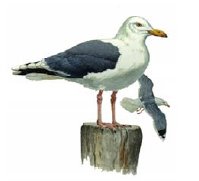TTAB Grounds Seagull Design Mark: Confusingly Similar to "SEAGULL" Word Mark
Applicant Abercrombie & Fitch never got off the ground in its attempt to escape a Section 2(d) refusal of the design mark shown immediately below (lined for the colors gray and yellow) for various clothing items "sold exclusively in Hollister Co. stores, catalogs, and online web-site," and for retail clothing store services. The Board found the mark confusingly similar to the word mark SEAGULL registered for clothing items and mail order catalog services in the field of clothing. In re Abercrombie & Fitch Trading Co., Serial No. 76516814 (June 28, 2006) [not citable].
 The Board observed that, despite the limitations regarding Applicant A&F's channels of trade, the goods of Applicant and Registrant are legally identical or closely related and the services "clearly" commercially related, "since to ordinary consumers, the respective services are simply alternative means of shopping for clothing and related accessories."
The Board observed that, despite the limitations regarding Applicant A&F's channels of trade, the goods of Applicant and Registrant are legally identical or closely related and the services "clearly" commercially related, "since to ordinary consumers, the respective services are simply alternative means of shopping for clothing and related accessories."The focus, then, was on the marks: is A&F's design mark "in essence a legal equivalent of registrant's 'SEAGULL' mark" -- bearing in mind that the degree of similarity necessary to support a likelihood of confusion is diminished when the goods and/or services are virtually identical? As stated in TMEP Section 1207.01(c)(i), "Under the doctrine of legal equivalents, a pictorial representation and its literal equivalent may be found to be confusingly similar."
Applicant A&F argued that consumers would not equate its design mark with the word
 "SEAGULL," but rather would "mentally translate the logo into the house mark" HOLLISTER CO. According to Applicant, "[c]onsumers do not view the Lacoste alligator design and say, 'I am buying an alligator shirt' -- rather, they know they are purchasing an IZOD shirt." Moreover, A&F pointed out, Applicant's goods may be purchased only through HOLLISTER CO. venues, and therefore "consumers will first make a conscious decision to purchase from Applicant's stores, web site or catalog when purchasing goods bearing the subject mark."
"SEAGULL," but rather would "mentally translate the logo into the house mark" HOLLISTER CO. According to Applicant, "[c]onsumers do not view the Lacoste alligator design and say, 'I am buying an alligator shirt' -- rather, they know they are purchasing an IZOD shirt." Moreover, A&F pointed out, Applicant's goods may be purchased only through HOLLISTER CO. venues, and therefore "consumers will first make a conscious decision to purchase from Applicant's stores, web site or catalog when purchasing goods bearing the subject mark."The Board, however, agreed with the PTO that the doctrine of legal equivalents should be applied. It took judicial notice of an encyclopedia entry for "gull," which included the illustration immediately below:

Moreover, Applicant described its mark as a "Seagull Design," and the mark is colored in the same way as a seagull. The PTO asserted that "[t]he mark consists solely of an accurate depiction of a seagull in flight" and that the average purchaser would recognize the mark as the equivalent of the word "seagull." The Board noted that Applicant's venues "look like a surfer's shack," and concluded that in this context of an "ocean-side or beach themed environment, consumers would readily recognize the design as equivalent to the word "seagull."
The Board therefore affirmed the refusal to register.
TTABlog comment: The Board gave no explanation as to why the limitations in Applicant's channels of trade were unimportant. In the ORION case last year, TTABlogged here, the Board rejected L.L. Bean's argument that confusion was unlikely because its fishing rods and reels were sold only through its own stores, catalogue, and website.
As to A&F's alligator/IZOD argument, the Board curiously asserted (apparently invoking judicial notice) that "it is common knowledge that shirts bearing such a design are typically referred to and known as 'alligator' shirts. In the same manner, purchasers of applicant's goods would be inclined to refer to its various items of apparel as 'seagull' shirts, etc." Shouldn't the Board have required some evidence that IZOD shirts are referred to as "alligator" shirts?
Reader Comment: Eagle-eyed reader Thomas M. sent me the following observation, which gave me a chuckle:
It's worth noting that the Applicant actually got the alligator, Izod, Lacoste example wrong in such a way that hurts their argument, had it been discovered.
The Applicant states, "[c]onsumers do not view the Lacoste alligator design and say, 'I am buying an alligator shirt' -- rather, they know they are purchasing an IZOD shirt."
I cite the GQ Style guy on this matter (here).
Today, the alligator shirt is made by Lacoste, not Izod. As of 1993, consumers might see the alligator and 'know' (in the words of the Applicant) that they are purchasing an Izod shirt, but they would be wrong. They are actually purchasing a Lacoste shirt.
If anything, they could have used the much simpler example that when consumers see three stripes on a shoe, they don't think of "three stripes," they think of Adidas. It's still a loser of an argument, but at least it's a sartorially proper loser.
Text Copyright 2006. John L. Welch.




0 Comments:
Post a Comment
<< Home